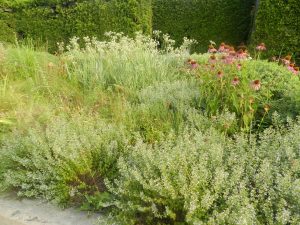
A xeric garden at the Lurie Gardens in Chicago’s Millenium Park includes Echinacea purpurea, Calamintha nepeta subsp. nepeta, and Eryngium yuccifolium.
When searching for a perennial that will survive in a hot, dry, sunny site, we need look no further than the genus Eryngium. Although most of the species are native to Europe and Morocco, they are hardy to at least zone 5 with some hardy even to zone 2, and, therefore, extremely useful here in northern Ohio. They are also tolerant of soil with high salt levels and thus useful in landscapes near streets and sidewalks that may be heavily salted during the winter. Even better, pollinators and butterflies love them while deer ignore then.
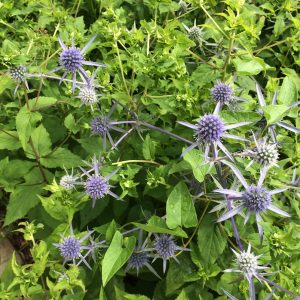
Eryngium planum ‘Blaukappe’ has been a mainstay in the xeric section of my garden for many years.
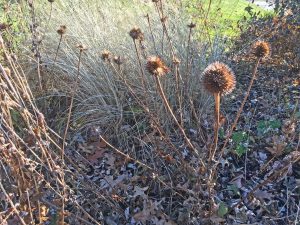
The deadheads of Eryngium planum ‘Blaukappe’ resemble small satellites.
The species most often used in our landscapes is Eryngium planum (Flat Sea Holly), a native of the Russian steppes and hardy to zone 5. ‘Blaukappe’ has silver-blue flower heads surrounded by bracts of the same color and grows two to three feet high. It stays in bloom from July until September and the deadheads make wonderful winter sculptures. Be aware, however, that leaving the deadheads will ensure that the seeds will then disperse and you will have more plants. Eryngium zabelli ‘Big Blue’ is similar but grows a bit taller and the flowers are larger. This is also an excellent plant for the cutting garden since the flowers last for quite a long time in either fresh or dried arrangements.
Like most Eryngium, the leaner and drier the soil, the better. Eryngium tends to flop where the soil is richer and moister. I have grown the cultivar ‘Blaucappe’ (‘Blue Cap’) for a number of years and have been quite happy with it. Its stems are particularly blue when temperatures are cool and the holly-like structure of its foliage adds a different texture to the garden’s composition.
Another commonly grown species is E.alpinum (Alpine Sea Holly) which is native to the Alps and hardy to zone 4. This species is a bit shorter than E.planum, being only one to two feet high. Again the basal foliage is heart-shaped but the stem is supposedly bluer. There are more bracts surrounding the flower head and is the most ornamental of the Eryngium.

I love the variegated foliage of Eryngium bourgatii.
An underused species is E.bourgatti (Mediterranean Sea Holly). This native of the Pyrenees, hardy to zone 5, is a compact plant that grows only one to two feet high and has dense, coarse, spiny foliage with silver veins. The bracts are also spiny and much longer than the silvery-blue flower heads which are small but multitudinous. E.varifolium (Moroccan Sea Holly) is similar with its conspicuous white veins but this one is more difficult to find and also more demanding in its cultural requirements, needing gritty, well-drained soil.
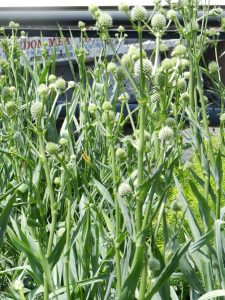
A closeup of Eryngium yuccifolium at The High Line in New York City.
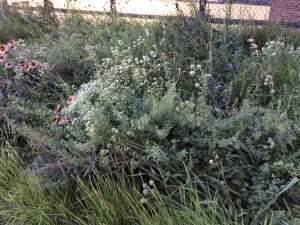
Eryngium yuccifolium mixed with Amorpha canescens, Calamintha white, grasses, Echinacea, and Aster in a dry prairie combination on the High Line.
There are two native American species that are fun to use in the landscape because of their unusual appearance. They are E.yuccifolium (Rattlesnake Master) and E.agavifolium (Agave Leaf Sea Holly). The former tends to grow three to four feet tall although it can grow as tall as six feet. Its stiff narrow leaves give the appearance of yucca foliage while the creamy white button flower heads with gray bracts quickly inform us that this is not a Yucca. The latter reminds me of the Sonoran Desert Agave although the foliage of the Eryngium is much narrower but just as spiny. Both species are hardy to zone 5 and are considered as collector’s items.
Don’t let the spines of the Sea Hollies scare you away. Their unusual texture and the steel to violet blue color are worth adding to the landscape.


1 Comment